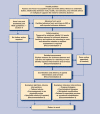NICE guidance on long-term sickness and incapacity
- PMID: 21375894
- PMCID: PMC3047344
- DOI: 10.3399/bjgp11X561221
NICE guidance on long-term sickness and incapacity
Abstract
Long-term sickness absence and incapacity benefits (disability pension) rates have increased across industrialised countries. Effective measures are needed to support return to work. The recommendations of this guidance were informed by the most appropriate available evidence of effectiveness and cost-effectiveness. Public health evidence was provided by research using a variety of study designs that attempted to determine the outcome of a particular intervention by evaluating status before and after the intervention had been effected, and was not limited to randomised control trials. Where the evidence base was depleted or underdeveloped, expert witnesses were called to give their opinion on the best available evidence and emerging interventions. The process enabled challenge and contestability from stakeholder groups at different points as the guidance was developed. Forty-five heterogeneous studies were included in the review of interventions to reduce long-term sickness absence and transitions from short-term to long-term absence (mainly covering the former and also mainly examining musculoskeletal conditions). The analysis of evidence was restricted to descriptive synthesis. Three general themes emerged from an analysis of the studies that were more likely to report positive results: early interventions; multidisciplinary approaches; and interventions with a workplace component. Two further reviews were undertaken, one on interventions to reduce the re-occurrence of sickness absence, which identified seven studies on lower back pain, and concluded that early intervention and direct workplace input are important factors. The final evidence review focused on six studies of interventions for those in receipt of incapacity benefit. The evidence was that work-focused interviews coupled with access to tailored support are effective and cost-effective interventions. Practitioners should consider the impact of interventions and management options on work ability for patients of working age. Work ability should be considered a key outcome for future intervention studies.
Figures
References
-
- Organisation for Economic Co-operation and Development (OECD) Sickness, disability and work: keeping on track in the economic downturn. Background paper. Paris: OECD; 2009. http://www.oecd.org/dataoecd/42/15/42699911.pdf (accessed 26 Jan 2011)
-
- Boorman S. NHS health and well-being final report. London: Department of Health; 2009.
-
- National Institute for Health and Clinical Excellence. Public health guidance 19. Management of long-term sickness absence and incapacity for work. London: National Institute for Health and Clinical Excellence; 2009. http://guidance.nice.org.uk/PH19 (accessed 26 Jan 2011)
-
- Department for Work and Pensions. Welfare Reform Bill. London: Crown Copyright; 2006. http://www.dwp.gov.uk/aboutus/welfarereform/#bill (accessed 26 Jan 2011)
-
- Health, Work and Wellbeing Programme. Dame Carol Black's review of the health of Britain's working age population. Working for a healthier tomorrow. London: The Stationery Office; 2008.
MeSH terms
LinkOut - more resources
Full Text Sources
Medical

